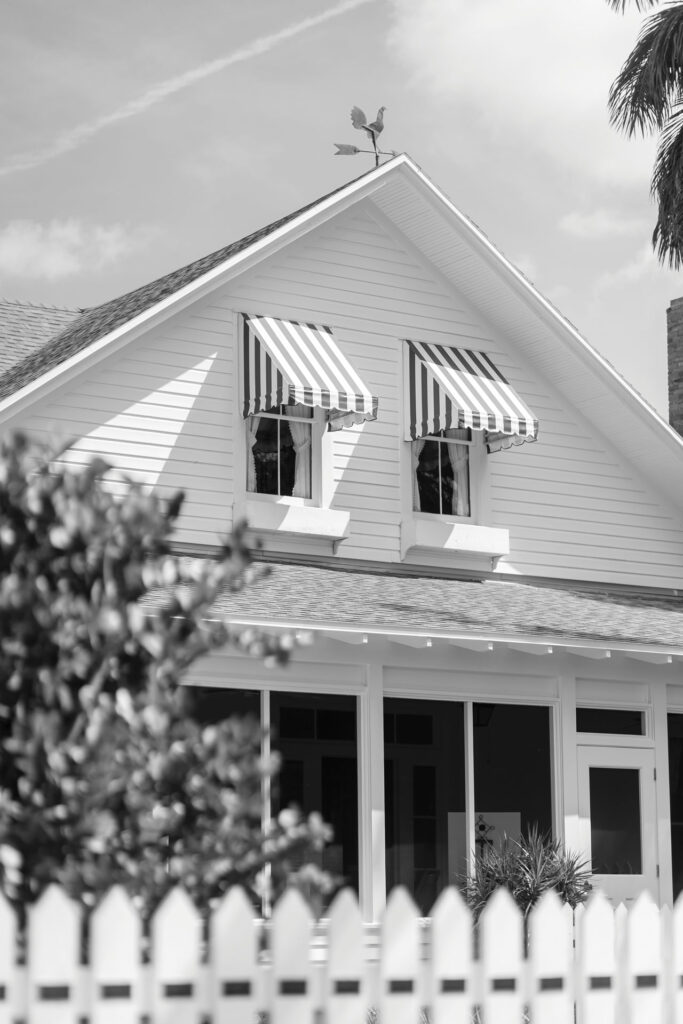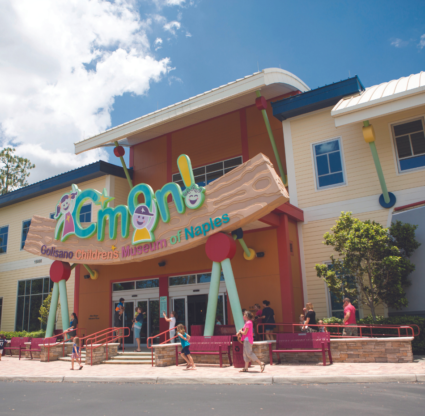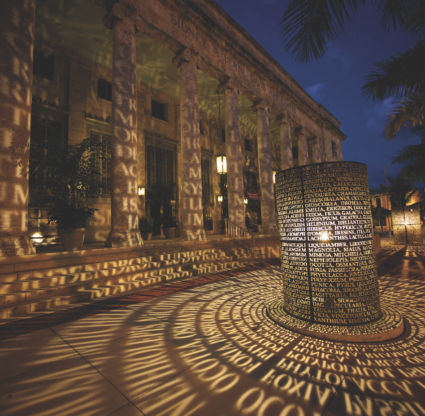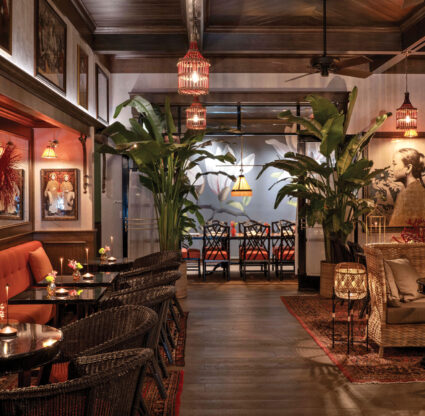Historic buildings contain our region’s memories. From Naples’ oldest home, the Historic Palm Cottage, and its elegant take on Florida Cracker architecture, to the Addison Mizner-designed Alderman House that recalls 1920s heyday Fort Myers—historic properties are essential to our architectural fabric.
When we polled our team about the places and things that make Southwest Florida special, a theme emerged among the design experts: They all pointed to historic homes. Here, Gulfshore Life board members David Corban and Dwayne Bergmann and our creative director, Scott Glick, share their favorite local buildings and why they find inspiration in the area’s oldest structures.

The Alderman House
Few architects have impacted South Florida architecture more than Addison Mizner. The California-bred 1920s impresario envisioned Palm Beach as an architecturally rich playground for the wealthy and created a trademark style defined by stucco facades, low-pitched, heavily tiled roofs and expansive mission-like properties. Mizner’s popularity spread across the Tamiami Trail with well-to-do Gulf residents who commissioned his designs. Only a few of his Mediterranean Revival manses remain in Southwest Florida, including The Alderman House by Mizner, near Downtown Fort Myers.
Surrounded by 100-year-old, 70-foot royal palms, the estate typifies Mizner’s take on Spanish Colonial design with its plentiful Roman archways, elegant spiral columns and breezy loggias. Our creative director, Scott Glick, says the home starkly contrasts the area’s more casual cottage style. “It’s a significant treasure that many don’t even know exists in Fort Myers,” he adds. Since the property’s not open for tours, the site flies relatively under the radar.
First National Bank of Fort Myers president Frank C. Alderman built the property as his family home in 1924. Over the years, the house has served as an office and retail space, an Airbnb rental, and now, one of the most elegant event venues in Southwest Florida. Current co-owner and on-site event planner, Cece Baschieri, loves the site’s stately spaces. “[In the entryway courtyard], the tile is original, and in every direction, you see arches,” she says. “I envision [the Alderman’s at a bistro table having coffee; [the home] takes you back to that time.”
Scott appreciates the global creativity in the architect’s work. “Mizner did not conform to any particular look but more of an amalgamation of his own, unique expression,” he says. “[The Alderman House still] reigns as the benchmark of classic, high society architectural style that many still pay homage to.”

Historic Palm Cottage
Charming is the first word that comes to mind when you see the picket fence-wrapped Historic Palm Cottage in Downtown Naples. Built as an annex for the 1895 Hotel Naples—one of the town’s first big structures—the five-bedroom home now serves as a museum and the headquarters for Naples Historical Society. Inside, you find historic furnishings and art, tracing Naples’ past, and relics pointing to illustrious guests, like the cottage’s first registry, signed by former acting First Lady Rose Cleveland.
While the hotel was torn down more than 50 years ago, the Palm Cottage remains, with its original pine floors, cypress paneling and tabby mortar structure (said to be the last local building made of the lime-shell-sand-ash cement mixture). “It’s one of the few places in Naples where you can step back in time,” the sustainably minded architect David Corban says.
While the Palm Cottage draws from 19th-century traditional Florida Cracker architecture—a simple, climate-responsive style Northerners developed, drawing from indigenous Seminole chickee huts—the home is grander than others of its time. The cottage flaunts Cracker-style raised floors, a pitched roof that allows hot air to rise, deep overhangs and large windows positioned for cross ventilation. Ceilings soaring to 12 feet, a cantilevered staircase and elegant, stained-wood trim speak to the home’s swanky roots.
David loves the floors made of Dade County Pine, a now-extinct building material. “It comes from [South Florida’s] first-growth forests,” David says. After Hurricane Ian battered the wood, restoring the floors was a key focus for the society. A specialized team took seven months to clean, dry and re-install each plank, preserving more than 90 percent of the floorboards.
With fewer than 60 historic homes left in Naples’ federally recognized Historic District, the society is fiercely intent on saving what remains. Now, they’re working on creating The Smith Exhibit Hall, housed in the recently acquired 1948 home adjacent to the cottage. “[The Historic Palm Cottage] allows us to see how the people who first moved to Naples lived and how things were built,” David says.

a cultural hub. The downtown building blends Old World and Old Florida, with its grand, ionic columns and Florida keystone facade. It took four years and tireless grassroots efforts from Sidney & Berne CEO Jim Griffith to restore the 23,000-square-foot structure. (Courtesy Sidney & Berne Davis Art Center)
Sidney & Berne Davis Art Center
On Downtown Fort Myers’ First Street, a hulking, 23,000-square-foot building commands the attention of passersby. The Neoclassical Revival Sidney & Berne Davis Art Center (SBDAC) was built in 1933 as a post office and served as a courthouse before sitting vacant for nearly a decade. “When I started coming to the area in 1999, 2000, Downtown Fort Myers was a ghost town,” Dwayne says. “This was way before the [SBDAC] restoration process, and my perspective was, quite simply: What a shame.”
Violist Jim Griffith shared Dwayne’s view and took it upon himself to write grants, raise funds, serve as contractor and otherwise hustle to restore the building and open it as a cultural center in 2007.
Nearly 20 years later, the site remains a visual anchor for downtown, with its portico entrance and Florida keystone facade. A thoughtful ode to past and present, the center has Jim Sanborn’s illuminated Caloosahatchee Manuscripts sculpture casting the story of American Indians’ migration into Florida across the front (a second Sanborn piece traces 500 botanicals Thomas Edison tested for making natural rubber). Three Rainer Lagemann anthropomorphic sculptures climb the building’s side, reflecting the center’s contemporary programming. “I love the grandiose nature of the columns and the sense of antiquity the building has gained through the natural aging process,” Dwayne says.
Jim continues to improve upon the structure through grassroots efforts. Fundraising is now underway for the next phase of restoration for SBDAC, an anticipated $2.5 million exterior refresh and a second large-scale outdoor sculpture garden. “For [the building] to be preserved so well, in such an artistic way, emphasizes how a community can evolve while remembering its past and creating a new vibrancy for today and into the future,” Dwayne says.




